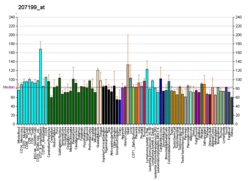Telomerase reverse transcriptase (abbreviated to TERT, or hTERT in humans) is a catalytic subunit of the enzyme telomerase, which, together with the telomerase RNA component (TERC), comprises the most important unit of the telomerase complex.[5][6]
Telomerases are part of a distinct subgroup of RNA-dependent polymerases. Telomerase lengthens telomeres in DNA strands, thereby allowing senescent cells that would otherwise become postmitotic and undergo apoptosis to exceed the Hayflick limit and become potentially immortal, as is often the case with cancerous cells. To be specific, TERT is responsible for catalyzing the addition of nucleotides in a TTAGGG sequence to the ends of a chromosome's telomeres.[7] This addition of repetitive DNA sequences prevents degradation of the chromosomal ends following multiple rounds of replication.[8]
hTERT absence (usually as a result of a chromosomal mutation) is associated with the disorder Cri du chat.[9][10]
- ^ a b c GRCh38: Ensembl release 89: ENSG00000164362 – Ensembl, May 2017
- ^ a b c GRCm38: Ensembl release 89: ENSMUSG00000021611 – Ensembl, May 2017
- ^ "Human PubMed Reference:". National Center for Biotechnology Information, U.S. National Library of Medicine.
- ^ "Mouse PubMed Reference:". National Center for Biotechnology Information, U.S. National Library of Medicine.
- ^ Weinrich SL, Pruzan R, Ma L, Ouellette M, Tesmer VM, Holt SE, et al. (December 1997). "Reconstitution of human telomerase with the template RNA component hTR and the catalytic protein subunit hTRT". Nature Genetics. 17 (4): 498–502. doi:10.1038/ng1297-498. PMID 9398860. S2CID 2558116.
- ^ Kirkpatrick KL, Mokbel K (December 2001). "The significance of human telomerase reverse transcriptase (hTERT) in cancer". European Journal of Surgical Oncology. 27 (8): 754–60. doi:10.1053/ejso.2001.1151. PMID 11735173.
- ^ Shampay J, Blackburn EH (January 1988). "Generation of telomere-length heterogeneity in Saccharomyces cerevisiae". Proceedings of the National Academy of Sciences of the United States of America. 85 (2): 534–8. Bibcode:1988PNAS...85..534S. doi:10.1073/pnas.85.2.534. PMC 279585. PMID 3277178.
- ^ Poole JC, Andrews LG, Tollefsbol TO (May 2001). "Activity, function, and gene regulation of the catalytic subunit of telomerase (hTERT)". Gene. 269 (1–2): 1–12. doi:10.1016/S0378-1119(01)00440-1. PMID 11376932.
- ^ Zhang A, Zheng C, Hou M, Lindvall C, Li KJ, Erlandsson F, et al. (April 2003). "Deletion of the telomerase reverse transcriptase gene and haploinsufficiency of telomere maintenance in Cri du chat syndrome". American Journal of Human Genetics. 72 (4): 940–8. doi:10.1086/374565. PMC 1180356. PMID 12629597.
- ^ Cerruti Mainardi P (September 2006). "Cri du Chat syndrome". Orphanet Journal of Rare Diseases. 1: 33. doi:10.1186/1750-1172-1-33. PMC 1574300. PMID 16953888.




